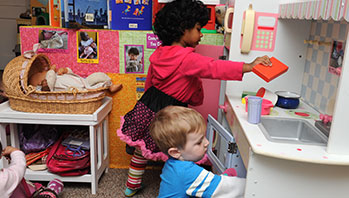- books about gardens
- empty seed packets (laminated if possible) or laminated pictures from seed/plant catalogues
- plastic flowerpots and planters
- sand or soil
- small cutout squares of construction paper or seed packages for flowers, fruits, and vegetables
- small wooden sticks
- toy hoes, rakes, shovels, spades, and watering cans
- flower
- fruit
- garden
- plant
- seed
- soil
- weed
- vegetable
MA Standards:
Speaking and Listening/SL.PK.MA.1: Participate in collaborative conversations with diverse partners during daily routines and play.
Head Start Outcomes:
Approaches to Learning/Initiative and Curiosity: Demonstrates flexibility, imagination, and inventiveness in approaching tasks and activities.
Logic and Reasoning/Symbolic Representation: Engages in pretend play and acts out roles.
PreK Learning Guidelines:
English Language Arts/Language 4: Engage in play experiences that involve naming and sorting common words into various classifications using general and specific language.
English Language Arts/Composition 18: Use emergent writing skills to make letters in many settings and for many purposes.
My Garden

© Commonwealth of Massachusetts, Department of Early Education and Care (Jennifer Waddell photographer). All rights reserved.
Skill Focus: Environmental Print, Imaginative Play, Listening and Speaking, Vocabulary
Explain to children that they will plant and care for a pretend garden—a place where flowers and vegetables are planted and grow. Display the seed packets or pictures and have children decide what type of fruits, vegetables, and/or flowers they would like to grow in their garden. Tell children to use the packets or pictures as their plant markers or labels so they can remember what they planted. They may want to tape a craft stick to the back to stand the packet up like the little boy in the story The Carrot Seed.
- Have children “plant” their garden in the pots/planters, arrange the pots and planters in rows, or straight lines, and pretend to take care of the garden.
- Encourage children to act out the motions of planting seeds, watering them, adding dirt, and pulling out the weeds.
- You may want to read the story The Carrot Seed by Ruth Krauss to children after they have completed "planting" their garden.
